When most of us hear “top ocean predator,” one animal immediately springs to mind. These are sharks. If you think the same, this article will surprise you.
Yes, some sharks are on the list of apex predators, but they are not the ultimate ones on the list, not even the Great White Sharks. Some marine creatures are capable of preying on these sharks. To know about them, you must read the article until the end.
But have a look at all 15 predators and one interesting fact about each.
| Predator Name | Interesting Fact |
| Atlantic Blue Marlin | One of the fastest fish in the ocean, capable of reaching 50mph |
| Bull Shark | Can adapt to both saltwater and freshwater environments |
| Dubois Sea Snake | Has venom 10 times more potent than that of a King Cobra |
| Giant Pacific Octopus | Can change its color and texture to blend into its environment |
| Great Barracuda | Has two sets of razor-sharp teeth that can be over an inch long |
| Great White Shark | Can grow up to 20ft in length and weigh over 4,000 pounds |
| Leopard Seal | Known to be the only seal species that feeds on warm-blooded prey |
| Moray Eel | Has a second set of jaws that can extend to catch prey |
| Orca (Killer whale) | Works in groups to hunt and can communicate through echolocation |
| Saltwater Crocodile | Has the strongest bite force (3700 PSI) in the animal kingdom |
| Sperm Whale | Has the largest brain of any animal on Earth |
| Stingray | Can deliver painful electric shocks to potential predators |
| Swordfish | Can swim at speeds up to 60mph and use their bills to hunt prey |
| Tiger Shark | Known for eating almost anything, from turtles to license plates |
The 15 Top Predators In The Ocean
Here is the detail of the top 15 marine predators from the bottom line.
15. Great Barracuda
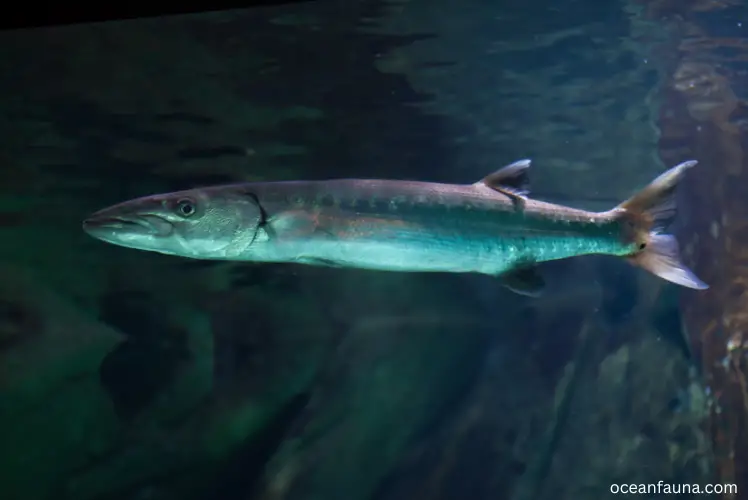
The Great Barracuda (Sphyraena barracuda) is the 15th in our list of fearsome predators that inhabit tropical and subtropical waters. These fish are famous for their impressive size and lightning-fast attacks.
Great Barracudas can grow up to 4.9 feet in length and weigh over 51 pounds. They have sleek, torpedo-shaped bodies that are perfectly adapted for speed and agility. Their jaws are filled with razor-sharp teeth that can damage their prey seriously.
These predators have a wide-ranging diet, including small fish, crustaceans, octopuses, and squid. They are known for their voracious appetite and will attack anything that catches their eye. Great Barracudas are also skilled hunters that use their lightning-fast speed to ambush and catch their prey.
One of the reasons why Great Barracudas are such effective predators is their incredible speed. They can swim at speeds of up to 36 miles per hour, making them one of the fastest fish in the ocean. This speed allows them to catch their prey off guard and launch a lightning-fast attack.
Great Barracudas can be found in a variety of different habitats, including coral reefs, rocky outcrops, and seagrass beds. They prefer warm, clear water and can be found in the Caribbean, the Gulf of Mexico, and the western Atlantic.
14. Atlantic Blue Marlin
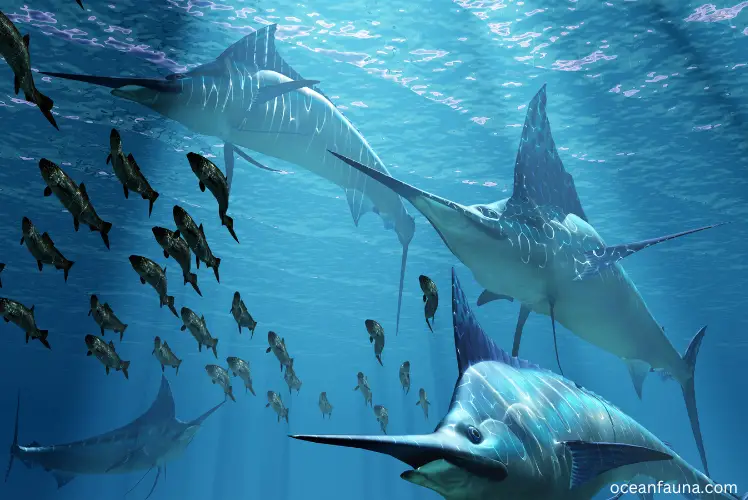
The Atlantic Blue Marlin, scientifically known as Makaira nigricans, is a top-level predator that inhabits the warm Atlantic waters. It is one of the largest species of marlins, with the ability to reach over 14 feet in length and weigh over 1,985 pounds.
As a predator, the Atlantic Blue Marlin is a highly skilled hunter, using its long bill to stun or kill its prey. Its diet mainly consists of large fish such as tuna, mackerel, dolphins, and squid. Its speed, agility, and bill make it a formidable predator that can easily catch its prey.
One of the reasons the Atlantic Blue Marlin is such a good predator is its excellent eyesight. Its eyes are on either side of its head, giving it a stereoscopic vision allowing it to spot prey from great distances. Additionally, the large size of the Atlantic Blue Marlin makes it an intimidating presence in the water, deterring smaller predators.
The Atlantic Blue Marlin can be found in the tropical and subtropical Atlantic Ocean, ranging from Newfoundland all the way down to Brazil. They prefer deep, open waters with temperatures ranging from 70 to 85 degrees Fahrenheit.
13. Giant Pacific Octopus
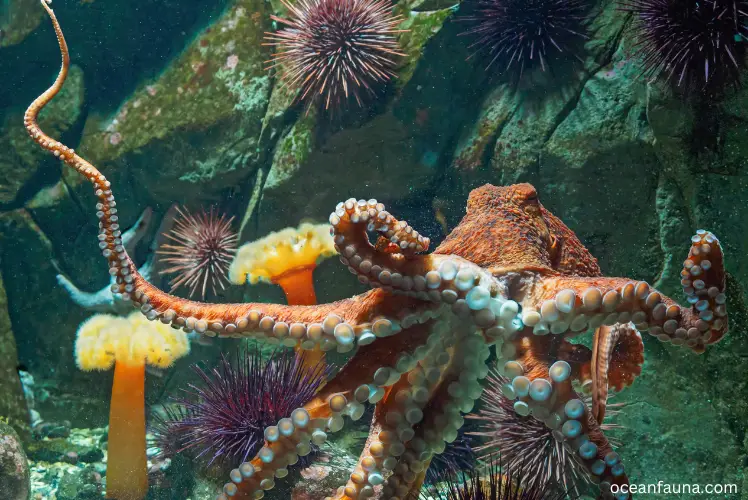
The giant Pacific octopus, also known by its scientific name Enteroctopus dofleini, is a formidable predator in the ocean. It is the largest species of octopus, with an average arm span of 16 feet, and can weigh up to 132 pounds. With its impressive size and strength, the giant Pacific octopus can overpower much larger prey than itself.
These intelligent creatures are ambush predators, lying in wait for unsuspecting prey before striking with lightning-fast speed. Their diet consists of a variety of creatures, including crabs, shrimp, clams, and small fish. They have also been known to hunt larger prey, such as sea birds and even other octopuses.
What makes the giant Pacific octopus such a good predator is its ability to blend into its surroundings. They can change the color and texture of their skin to match their environment, allowing them to effectively camouflage and ambush their prey.
Moreover, they possess powerful beaks and sharp, venomous suction cups that enable them to capture and subdue their prey.
The giant Pacific octopus is commonly found in the temperate waters of the Pacific Ocean, ranging from California to Alaska and Japan. They prefer rocky areas with plenty of hiding places, such as crevices and caves. Due to their solitary nature and preference for hiding, they are often difficult to spot in the wild.
12. Stingray

The Stingray, scientifically known as Myliobatoidei, is a fascinating marine predator that belongs to the family Dasyatidae. They are cartilaginous fish and are closely related to other rays and sharks. Stingrays are known for their unique flattened body structure, which helps them to move through the water effortlessly.
Stingrays come in a variety of sizes, ranging from small species to larger ones that can measure up to 8.2 feet in length. The average weight of a stingray is around 200-300 pounds, depending on the species.
Stingrays are carnivores and primarily feed on fish, shrimp, crabs, and other small marine animals. They have a unique way of hunting: hiding in the sand or mud, waiting for prey to swim by, and then attacking it with their sharp venomous tail spine. They also use their five sensory organs to locate prey, including their electroreceptors, which allow them to detect the electrical impulses produced by their prey.
Stingrays are considered good predators due to their agility and strength, which allows them to take down larger prey. Their pectoral fins are specially adapted to create water currents, giving them more maneuverability and making them difficult for their prey to catch.
Stingrays can be found in various habitats, including shallow coastal waters, coral reefs, deeper offshore waters, lagoons, and estuaries. They prefer warmer waters and tend to migrate towards areas that offer a better food source.
11. Leopard Seal

The Leopard Seal, scientifically named Hydrurga leptonyx, is a formidable predator of the Southern Ocean in the Antarctic region. These seals have a sleek and powerful bodies, allowing them to hunt efficiently in the water. Adult seals can grow up to 11.5 feet in length and weigh up to 1320 lbs.
Leopard Seals are known to have a diverse diet, and they can eat almost anything they can catch in the water, including fish, squid, krill, and other pinnipeds such as Weddell seals and penguins. They are opportunistic predators and can travel long distances to find food, making them highly adaptable to their environment.
One of Leopard Seals’ greatest skills lies in their advanced hunting technique, a key factor that has enabled them to be such successful predators.
Unlike other seals that rely mainly on their teeth and jaws to catch prey, Leopard Seals use their sharp front claws to grab and hold their prey while using their powerful jaws to crush their victim’s skull. They are also known to be solitary hunters, which allows them to conserve energy and be more efficient when hunting.
Leopard Seals are mainly found in the Antarctic region and can be observed along the edges of pack ice, where they hunt for penguins and other prey.
In addition to their predatory behavior, Leopard Seals are also known for their vocalizations, including grunting, moaning, and growling, which they use to communicate with each other and establish dominance over their territory.
10. Dubois Sea Snake
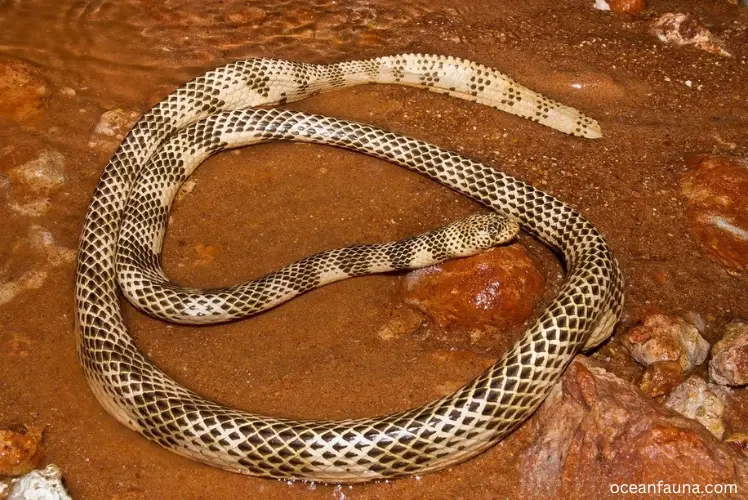
The Dubois Sea Snake or Aipysurus duboisii is a venomous species of sea snake belonging to the family Elapidae, found in Papua New Guinea and Australian waters. This species is known to be a powerful and efficient predator in its habitat.
In terms of size, the Dubois Sea Snake typically grows up to 1.09 meters in length, with females being slightly larger than males. As for weight, they usually weigh around 1 to 1.5 kg. With their sleek and slender bodies, these snakes are able to swiftly move through the waters in search of prey.
The diet of Dubois Sea Snakes mainly consists of eels and fish, with occasional crustaceans and other small marine animals. They are known to be skilled hunters, using their sense of smell to locate prey and then using their venomous bite to immobilize and kill it. Their venom is highly toxic and can paralyze their prey’s nervous system, making it impossible for them to escape.
The Dubois Sea Snake is deemed a successful predator for its capacity to evolve with its environment. They are excellent hunters in both shallow and deep waters, and their activity extends far beyond the daylight hours into the night as well. Also, their venom is highly effective against their prey, allowing them to quickly and efficiently subdue their target.
The Dubois Sea Snake is typically found in tropical waters near coral reefs and rocky outcrops. They can live in both shallow and deep waters and use crevices and holes as hiding places when not hunting. Due to their venomous nature and the potential danger they pose to humans, approaching or handling Dubois Sea Snakes is not advisable.
9. Saltwater Crocodile
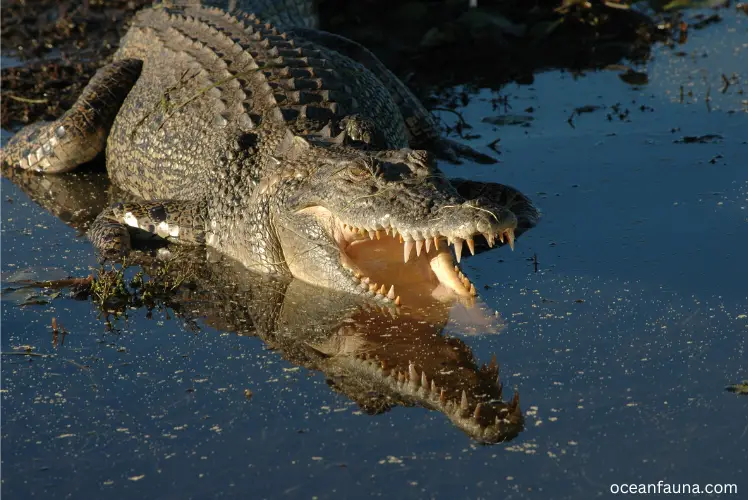
Saltwater Crocodile, also known as Crocodylus porosus, is one of the largest predators on the planet. These reptiles can grow up to 6-7 meters in length and weigh around 1,000-1200 kilos. They have powerful jaws, strong tails, and razor-sharp teeth, making them the dominant predator in their habitat.
Their diet primarily consists of fish, birds, snakes, turtles, and small mammals. However, when they grow older and larger, they can hunt bigger animals such as water buffalo, wild boar, and even sharks.
Saltwater crocodiles are excellent predators because of their stealth, patience, and strength. They can remain hidden under the water’s surface for extended periods, waiting for their prey to come near. With their quick reflexes, they can launch themselves out of the water to catch their prey, delivering a powerful bite that can kill instantly.
Saltwater crocodiles are found in brackish and freshwater habitats across Australia, Southeast Asia, and India. They make their homes in rivers, swamps, lagoons, and estuaries. They are territorial in nature and can fiercely defend their territory from any intruder, including humans.
Saltwater crocodiles have been known to attack and kill humans, making them one of the most dangerous and feared predators in the ocean and on the planet.
8. Moray Eel
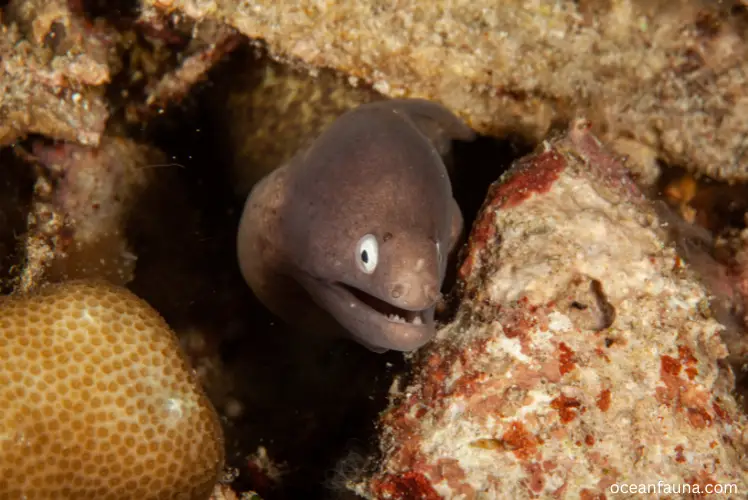
The Moray Eel, known as Muraenidae, is a fearsome predator in tropical and subtropical waters worldwide. These eels can grow up to 13 feet in length (average 6-8 feet) and weigh up to 66 pounds, making them one of the largest predatory fish in the ocean.
Moray Eels are carnivores and feed on fish, crustaceans, and cephalopods. Their powerful jaws and sharp teeth allow them to easily capture their prey, and their flexible bodies allow them to sneak into tight crevices and hunt in narrow spaces that larger fish cannot reach.
Moray Eels are some of the most successful predators in the ocean – and it’s no surprise why. Their sense of smell is particularly impressive, which allows them to detect prey from afar.
Poor eyesight may be a hindrance for others, but this doesn’t stop these cunning hunters. They possess an advanced lateral line system that helps them locate their victims by sensing any movements or vibrations in the water. With such highly honed senses, nothing stops these eels from achieving success as predators.
Moray Eels are primarily found in shallow coral reefs but can also be found in rocky areas and sandy bottoms. They prefer areas with plenty of hiding places and will often burrow into the sand or hide in crevices during the day, only emerging at night to hunt.
7. Swordfish
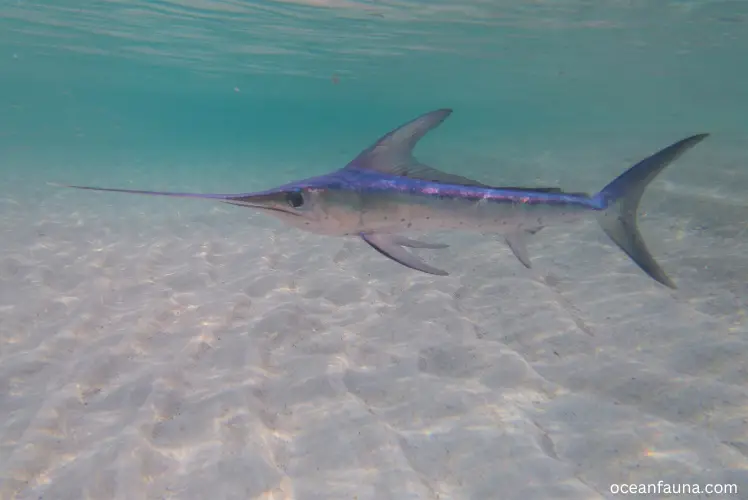
Swordfish, scientifically known as Xiphias gladius, is a formidable predator that inhabits the world’s oceans, except the Arctic and Antarctic regions. It is a highly migratory species that can cover vast distances in search of prey.
The Swordfish is one of the largest predators in the ocean, with a typical length of up to 15 feet (average 12-14 feet) and a weight that can reach up to 1,400 pounds (650 kg). It is also known for its elongated bill, primarily used to slash and stab its prey.
As for its diet, swordfish feed on a variety of prey, including squid, shrimp, and small fish, but their primary target is usually larger fish, such as mackerel, herring, and even tuna. Even sometimes, swordfish stab sharks to defend themselves and compete for food.
Swordfish are especially good predators because they are fast swimmers, with speeds of up to 60 miles per hour. They also have exceptionally sharp reflexes and excellent eyesight, which makes them effective hunters even in murky waters.
Swordfish are found in a range of habitats, from temperate to tropical waters around the world, as long as the water temperature ranges from 64 to 72 degrees Fahrenheit (18 to 22 degrees Celsius). They are typically found in open waters and are known to migrate long distances in search of food and suitable breeding grounds.
6. Bull Shark
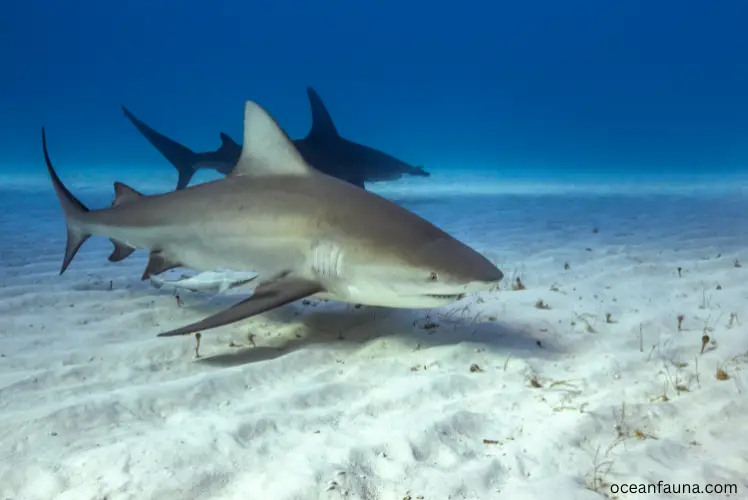
The Bull Shark, also known as Carcharhinus leucas, is a formidable predator found in warm shallow coastal waters worldwide. It is considered the most dangerous shark to humans because it tends to attack in freshwater environments, such as rivers and estuaries.
Bull Sharks can grow up to 7 feet (male) 11 feet (female) in length and weigh up to 500 pounds, making them one of the larger shark species. They are excellent predators due to their strong and muscular bodies, powerful jaws, and sharp teeth. They have a unique ability to regulate the salt content in their bodies, allowing them to swim in both saltwater and freshwater environments.
Bull Sharks have a varied diet, consisting of small fish, sea turtles, crustaceans, dolphins, and other sharks. They are known for their aggressive hunting behavior and their ability to prey on larger animals due to their size and strength.
In fact, Bull Sharks have been observed hunting and killing adult hippopotamuses and crocodiles, making them one of the few shark species that can take down such formidable prey.
Bull Sharks have a distinct advantage in predation, as they can thrive in numerous aquatic habitats. They are comfortable swimming in shallow waters close to shorelines and can tolerate oxygen-depleted areas deep within the ocean, an ability that no other shark species share.
This unique trait makes them capable of preying on animals otherwise out of reach for their competition.
5. Tiger Shark
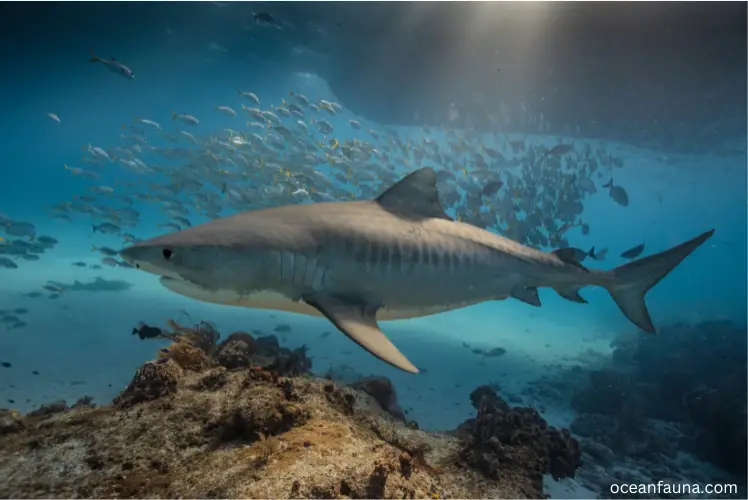
The formidable tiger shark (Galeocerdo cuvier) is one of the biggest species of shark, capable of growing to an enormous 14 feet in length and weighing up to 1,400 pounds. Not only this, but these aquatic giants are renowned for their predatory behavior – making them a force to be reckoned with underwater.
Tiger sharks are opportunistic predators and have a varied diet consisting of fish, sea turtles, birds, and even other sharks. They have been known to consume a variety of marine animals, including dolphins, rays, and even sea snakes.
What makes tiger sharks such efficient predators is their unique ability to consume almost anything they come across. They have a powerful jaws equipped with serrated teeth that can cut through the toughest of prey. Also, tiger sharks have a highly developed sense of smell and can detect prey from miles away, even in murky waters.
Tiger sharks are found in tropical and subtropical waters worldwide, including the Pacific, Indian, and Atlantic Oceans. They are typically found in shallow coastal waters but also venture out into the deeper parts of the ocean.
4. Giant Squid
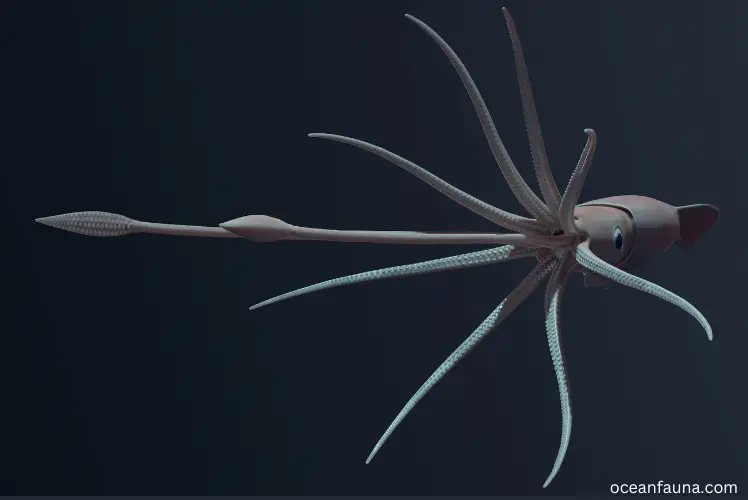
Giant Squid, or Architeuthis in scientific terms, is a formidable predator that inhabits the deep ocean. These creatures can grow up to 59 feet in length, making them one of the largest invertebrates in the world. They can weigh up to a ton, with their massive tentacles equipped with suckers and hooks to capture their prey.
The giant squid is an opportunistic predator that feeds on various marine creatures, including fish, shrimp, and other squids. They are known to have a voracious appetite, with some specimens found to have as many as 700 partially digested prey items in their stomachs.
Giant squids are renowned as ferocious predators, thanks to their impressive tentacles and ambush tactics. These magnificent animals possess long appendages that they use to grasp unsuspecting prey before drawing them toward their beaks.
But it doesn’t stop there. These creatures can also produce bioluminescent flashes, which enable them to temporarily blind and paralyze their targets – making the hunt even more successful!
The giant squid is found in all the world’s oceans, with most sightings occurring in deep waters. These creatures have been known to live at depths of up to 2000 feet below the surface, making them incredibly difficult to study in their natural habitat.
3. Sperm Whale

The Sperm Whale, also known as Physeter macrocephalus, is a formidable apex predator of the deep sea. They are the largest toothed predator on Earth and have a unique body that allows them to dive to incredible depths in pursuit of their prey. Adult males can grow up to 60 feet in length and weigh up to 57 tons, while females are slightly smaller at around 40 feet and 25 tons.
Their diet predominantly consists of giant squid, which they hunt at depths of up to 3,000 meters. Sperm Whales have the largest brain of any animal, which enables them to use echolocation to track their prey in the inky blackness of the deep ocean. They also have powerful jaws and teeth that can easily crush the shells of the giant squid.
Sperm Whales are supreme hunters, having evolved to perfectly fit their marine environment. Their low metabolism allows them to hunt for up to an hour without needing oxygen, and the thick blubber layer that covers their body keeps them snugly insulated from even the chilliest depths.
What’s more, these whales can dive deeper than any other predator on Earth – granting access to a bounty of prey otherwise out-of-reach!
Their habitat ranges across all the world’s oceans, with the largest populations found in the deep waters off the coast of Norway, New Zealand, and the Azores.
2. Great White Shark
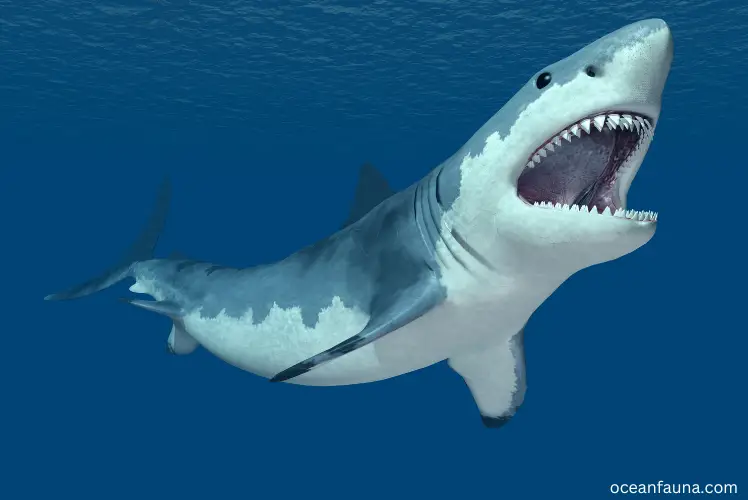
While the great white shark is often cited as the ocean’s top predator, I place it second.
The Great White Shark, also known as Carcharodon carcharias, is a powerful predator that reigns over the oceans as one of the deepest’s most feared creatures. With a size that can reach up to 20 feet and a weight of over 4,500 pounds, they are the largest predatory fish in the world.
Great White Sharks are known for their incredible hunting skills and are one of the top predators in the ocean. Their diet mainly consists of fish, seals, sea lions, and other marine mammals. They use their sharp teeth and immense jaws to catch and devour their prey, and their powerful bodies allow them to move quickly through the water, making them even more formidable predators.
Their great sense of smell and ability to detect electrical fields in the water makes them highly skilled hunters, even in the ocean’s murky depths. They also have exceptional sight, enabling them to see prey from great distances and depths.
Great White Sharks can be found in almost every ocean in the world, from the warm waters of the tropics to the freezing waters of the Arctic. They are often found near coastlines, where they can hunt for seals and other marine mammals in shallow waters.
1. Orca (Killer Whale)
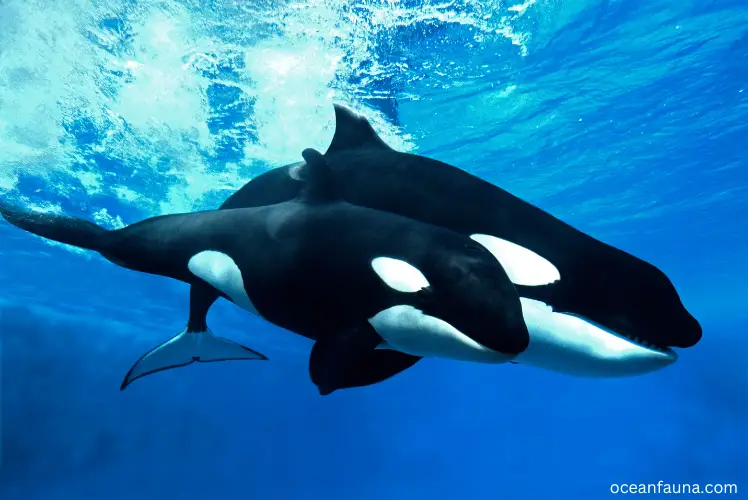
In my list, the orca is the ultimate ocean predator that can even take down great white sharks. Read also to know more about – “Shark and Killer Whale.”
Now, the orca (Orcinus orca), also known as the killer whale, is a marine mammal that is widely recognized as one of the ocean’s top predators. Its scientific name is Orcinus orca, and it is the largest member of the dolphin family.
The mightiest male killer whale on record measured an impressive 32 feet and weighed a whopping 22,000 pounds. On the other hand, the largest female specimen was 28 feet in length and weighed up to 16,500 pounds. Their bodies are sleek and powerful, with black and white patterns that are unique to each whale.
Orcas are known for their varied diet, which can consist of fish, squid, octopus, seals, sea lions, penguins, and even other marine mammals such as dolphins and whales. They are also known to hunt in packs or pods, which makes them successful predators. Orcas have sharp teeth that can easily grip and tear through their prey, and their strong jaws allow them to crush bone.
Orcas are excellent predators due to their physical attributes, such as their speed, agility, and intelligence. They can swim up to 56 km/h and dive down to depths of over 100 meters. They have a keen sense of hearing and can echolocate, which helps them locate and track their prey. Their intelligence also allows them to hunt coordinatedly, which is crucial in catching larger prey.
The main reason why the orca is the ultimate predator of the ocean is its ability to catch the creatures that other predators can’t. With their immense size and strength, Orcas are able to take down marine species that are much larger than themselves. This includes great white sharks, which they have been known to hunt and devour.
Orcas are found in the world’s oceans and can live in various habitats, from the Arctic to the tropics. They are highly adaptable and have been known to migrate long distances in search of food. However, they are most commonly found in colder waters such as those in the Arctic, Antarctic, and North Pacific.
Conclusion
So, now you have a detailed list of the 15 top predators of the ocean. And, here, the orca is the ultimate. If you want to know more about all these creatures, contact us or keep your question in the comment box.

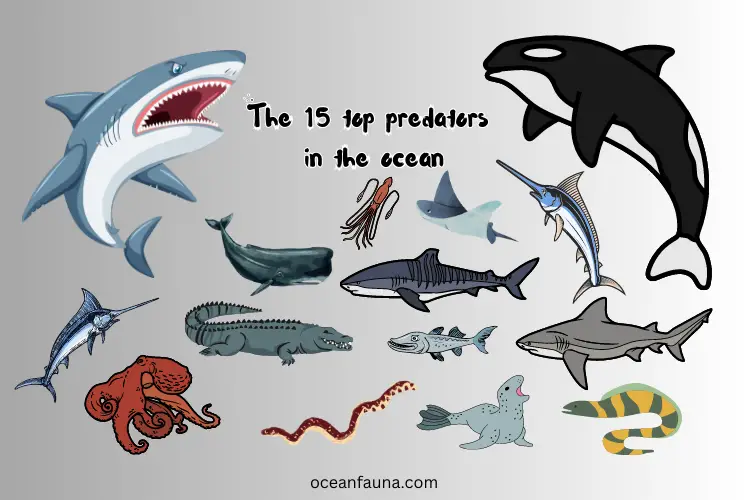
6 thoughts on “15 Top Predators In The Ocean With Pictures”